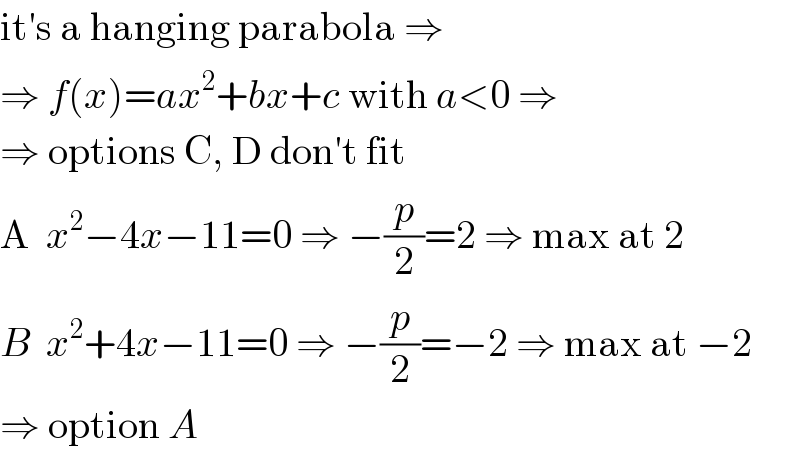
Question and Answers Forum
Question Number 58816 by Tawa1 last updated on 30/Apr/19

Answered by Kunal12588 last updated on 30/Apr/19
![from looking the graph we can say that maxima of function is at x=2 for A) ((d(f(x)))/dx)=0 [for minima or maxima] −(1/3)×2(x−2)(1)=0 ⇒x=2 option A can be correct for B) ((d(f(x)))/dx)=0 −(1/3)×2(x+2)(1)=0 ⇒x=−2 option B is not correct for C) ((d(f(x)))/dx)=0 (1/3)×2(x+2)(1)=0 ⇒x=−2 option C is not correct for D) ((d(f(x)))/dx)=0 6(x−2)(1)=0 ⇒x=2 ∴ only A or D options can be correct now lets find the zeroes of A and D A. −(1/3)(x−2)^2 +5=0 ⇒(x−2)=±(√(−(5)(−3))) ⇒x=2±(√(15)) D. 3(x−2)^2 +5=0 ⇒(x−2)=±(√(−(5/3))) ⇒x=2±z ⇒x∉ R But zeroes of the equation in the graph are Real ∴ Only A is correct Ans. A. f(x)=−(1/3)(x−2)^2 +5](Q58820.png)
Commented by Kunal12588 last updated on 30/Apr/19

Commented by tanmay last updated on 30/Apr/19

Commented by Tawa1 last updated on 30/Apr/19

Commented by Kunal12588 last updated on 30/Apr/19

Answered by MJS last updated on 30/Apr/19

Commented by Tawa1 last updated on 30/Apr/19

